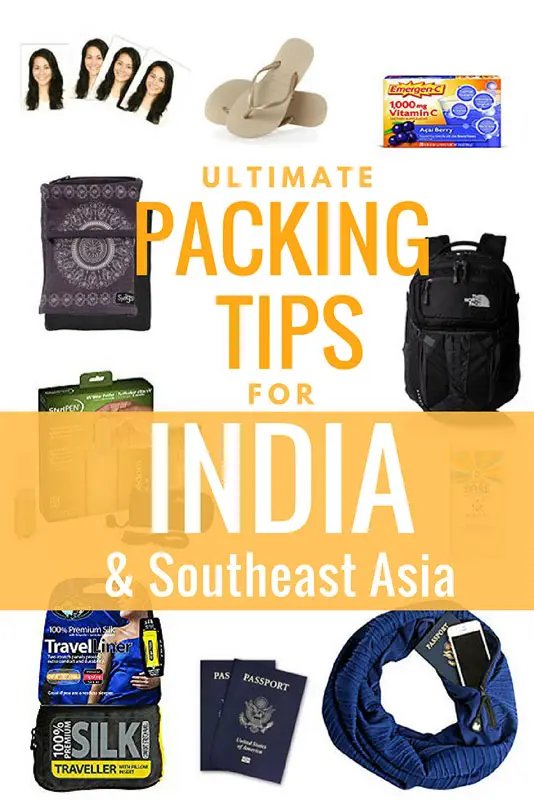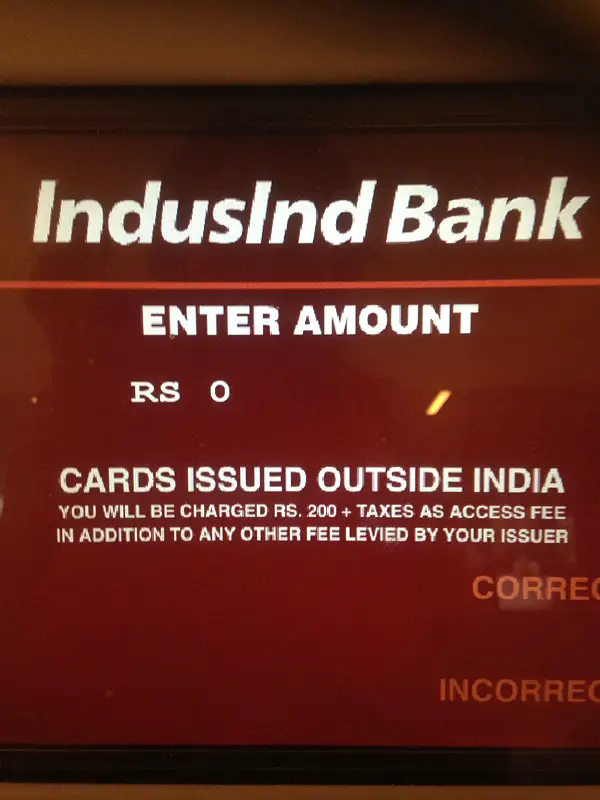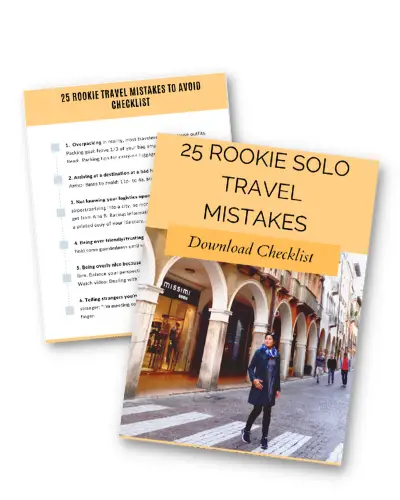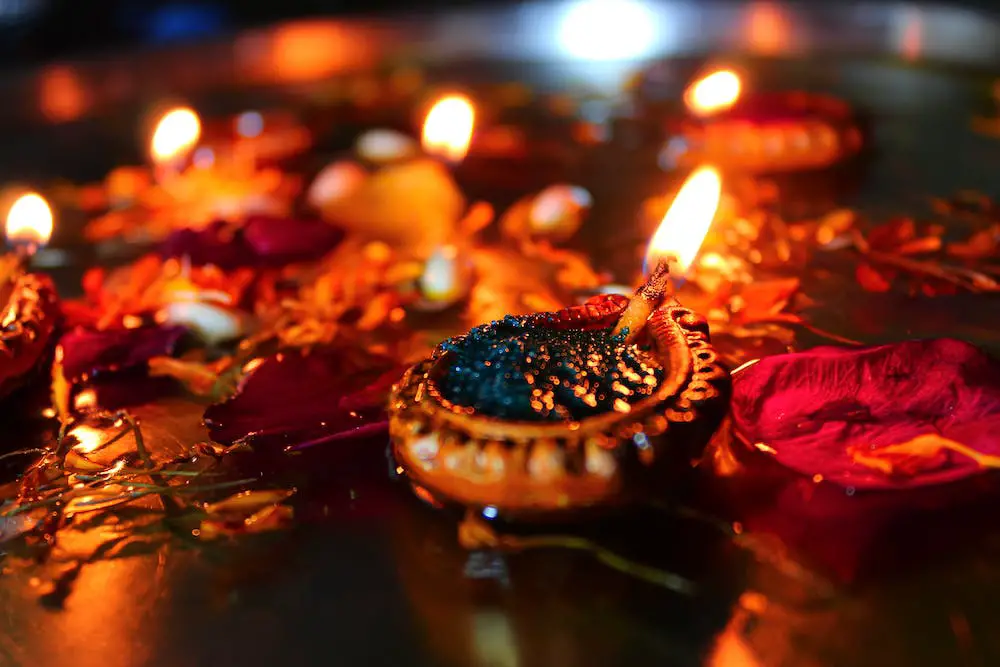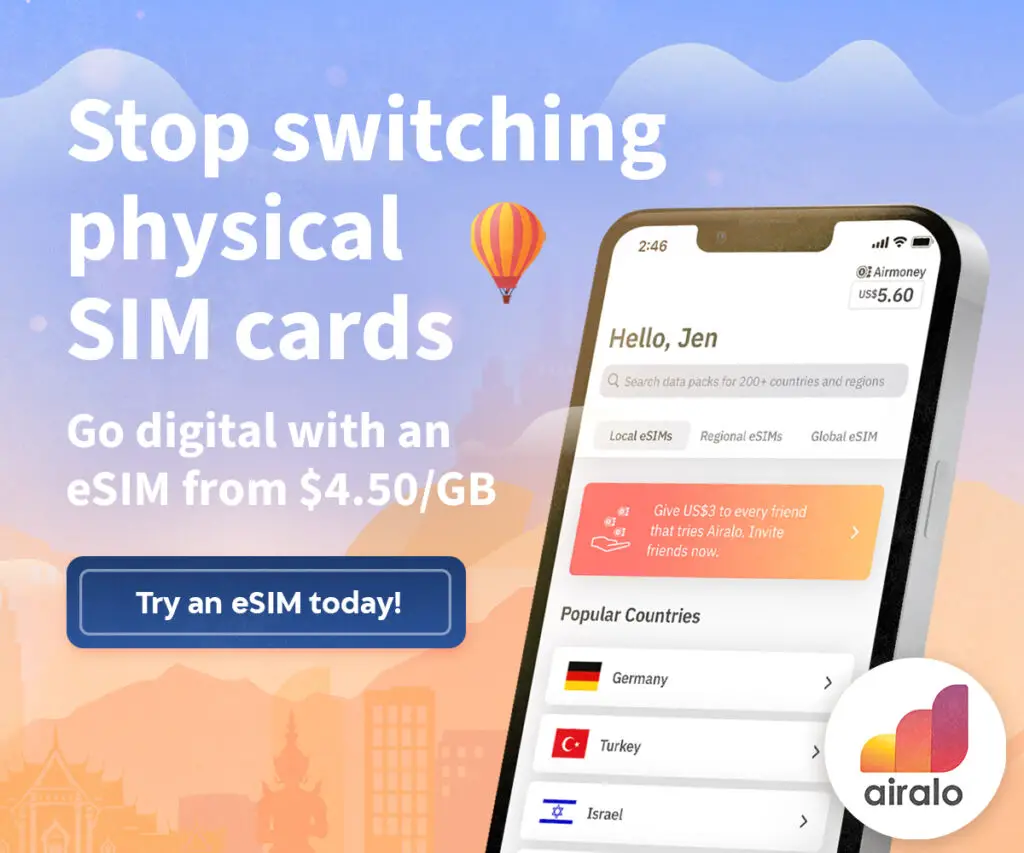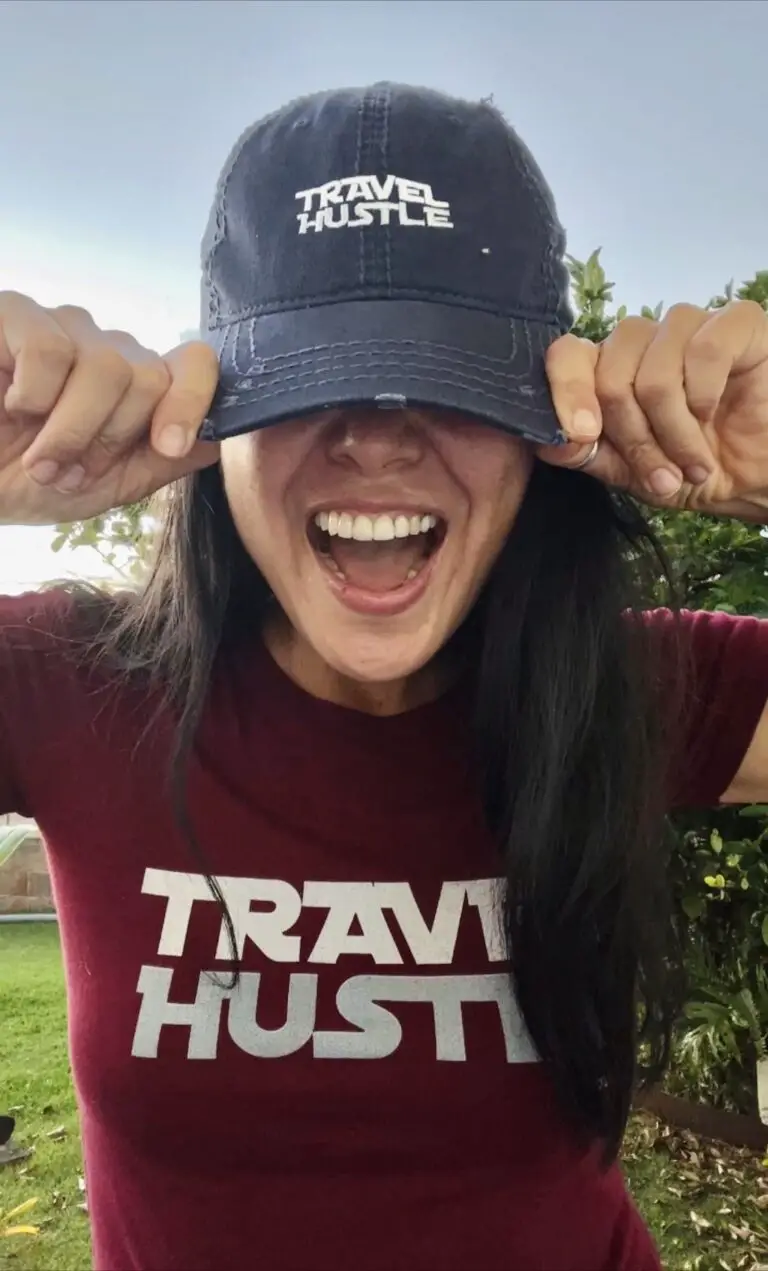Ultimate Packing tips for India | What’s in my Backpack?
Namaste! India can be a challenging and complex country but also very rewarding once you feel like you’ve prepared for it. I am sharing my India packing tips and essential packing list for India (and Southeast Asia). I am traveling for a total of three months. I am traveling to India for 30 days on an India e-Visa and it is sandwiched between my trips to Thailand, Borneo and Taiwan.
Essential Packing List for India and Southeast Asia
Table of Contents: Essential Packing List for India (& Southeast Asia)
- 1 Essential Packing List for India and Southeast Asia
- 1.1 Important Documents for India & Southeast Asia
- 1.2 Southeast Asia & India Packing List for Backpacking
- 1.3 Southeast Asia & India Packing Tips for Travel Health
- 1.3.1 12. Travel Insurance
- 1.3.2 13. Water Purifiers
- 1.3.3 14. Medicine kit
- 1.3.4 15. First aid kit
- 1.3.5 16. Vitamins
- 1.3.6 17. Sunscreen
- 1.3.7 18. Mosquito repellent or Permethrin treated clothes
- 1.3.8 19. Lip Balm
- 1.3.9 20. Lemongrass Oil
- 1.3.10 21. Melaleuca Spray (or Solumel)
- 1.3.11 22. Door stopper (for solo women… and men)
- 1.3.12 23. Baby Wipes
- 1.3.13 24. Hand sanitizer
- 1.3.14 25. Feminine Urinary Device (optional)
- 1.3.15 26. Tissues or Toilet paper
- 1.4 Packing List for Electronics
- 1.5 Packing List for Money & Currency
- 1.6 Solo Travel Packing Essentials for Luggage
This video will share with you the essential things that I’m packing for my solo trip to India and beyond. As a solo female traveler, taking Indian trains and various types of transportation to get around India, the best way to pack for India is minimally and light. So I am bringing one carry-on luggage and a daypack.
Important Documents for India & Southeast Asia
Although most Southeast Asia governments are fairly friendly about travelers crossing borders overland, you will need to carry the right visas either in advance or upon arrival. India’s government however, is very bureaucratic. Many things are handled by paperwork and its lack of technology can feel behind times. Getting a visa for India or an India SIM card may feel challenging in application forms, so I hope my essential packing tips for India will help.
1. Passport (Valid for the next 6 months)
Like your credit card, never leave home without your passport. It needs to be valid for the next six months, so if it’s expiring soon, it’s time to get a new passport.
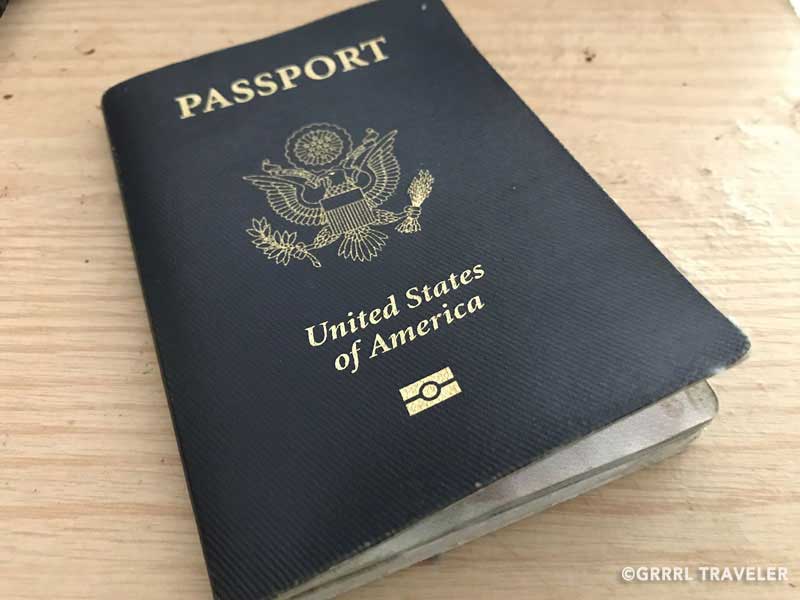
2. India Visa (for U.S. citizens)
The India Visa upon Arrival grants you 30 days per single entry. You are only allowed one entry. If you want the ten year- multiple entry visa, you need to apply through the embassy. Looking for a six month tourist visa?
Read: Step-by-step Guide: Applying for an India Visa (US citizens)
– Upload a digital copy of your passport photo (10kb to 300kb) and of your passport Bio page. Getting your passport page down to the size they require for upload will take a few Photoshop tries at resizing and cropping. It won’t be the actual size of your passport page when you finish, so make sure the details of your information is clear.
– Processing time takes approximately 72 hours.
– Apply online at least 4 days before departure.
– Have a week’s worth of accommodation planned (or at least so for the application). The tricky part of India visas are always proof of booking or onward travel. For an Indian visa upon arrival, you need your first week’s hotel booking. It will ask you for address and dates. A sly trick travelers use is Booking.com -an online booking service which doesn’t charge cancellation fees. The book a hotel on Booking.com and then cancel later.
– Visa is sent via email; print it out. I always make sure I have a copy also on my mobile phone.
– Application website is here.
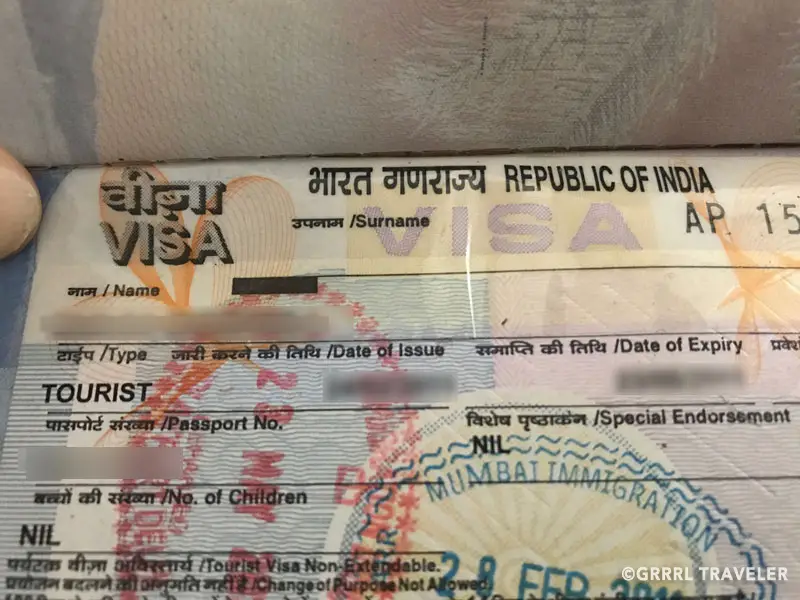
3. Copies of passport page & extra passport photos
I always take multiple copies of my passport page and extra passport photos, whenever I travel. This is because I make a lot of last minute decisions on where to go. If I need a travel visa for a country that I serendipitously want to enter, it’s a 50-50 chance I’ll end up needing passport photos and a copy of my passport page.
If you plan to get an Indian SIM card, these two documents are a requirement.

Southeast Asia & India Packing List for Backpacking
4. A guidebook
I used to be a fan of Lonely Planet, but somewhere along the lines, I felt Rough Guides was more intuitive and quicker for me to navigate. Today, I mostly use Rough Guides. Rough Guides India is beheamoth, so instead of carrying a paper weight in my bag, I like to take only the chapters I think I’ll use. Click here to see how I do it.
5. A Wrist Wallet
A lot of times I’m dealing with small change in India. I’m visiting small markets and buying food on the streets. So I don’t like to carry a wallet. Often, I’ll use my Wrist Wallets for convenience, safety and speedy accessibility. (Read review) Travel scarves with zippers are also handy to have as a purse which doesn’t look like one.

6. Moleskine notebook
Although I no longer use my moleskine notebook for journaling, my travel notebook is always handy, especially in times of communication and language barriers. Also, in India, I often find myself working with travel agents to book my onward travel~ a train, bus, etc… – and I like to take notes to figure out what times, connections and prices I’m juggling. I also use it to write directions. What I love also is that there’s a little back pocket where I can store hotel business cards and tour itinerary flyers.
7. Sarong
Sarongs are one of those multipurpose travel items, which come in handy in more ways than just one. You can use it as a scarf, but often, it’s a substitute for a travel towel and occasionally, it’s also been a great shawl, blanket and scarf.
8. Scarf
I always take a Pashmina Shawl on my travels. Always. Maybe I just love the scarf fashion but it’s always come in handy for me as an extra layer of warmth for an air-conditioned plane, train or bus. It’s also handy to have as a head cover for temples.
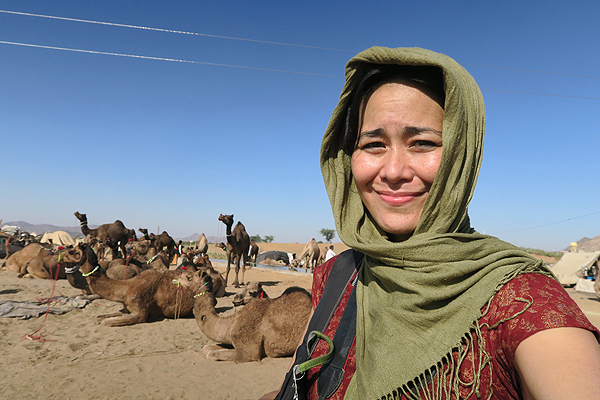
9. Silk Liner
Whether I’m in a hotel, guesthouse or hostel, I pack my Sea to Summit Silk Liner. At least, it’s an extra silk layer of warmth for cold areas I never planned for. At most, it’s a protective layer against hostel sheets and bed bugs.
10. Sleeping Bag
India can have extreme weather. In southern states like Kerala or Hampi the heat can run dry to humid. In the northwest of Rajasthan, the heat is dry as dessert. In such regions, a silk liner or bed sheets will suffice.
However, there are cold regions in the Northern mountains and hill stations, which can run brisk.When I stayed in Dharamsala for a month to do my yoga teacher’s certification program, there were nights my sleeping bag and silk liner did not feel like enough. In Ladakh, I’ve even seen snow! Check the weather for the regions you’ll be visiting.
11. Flip flops
I highly recommend packing a good pair of flip flops or sandals. If you are staying in a Southeast Asian hostel, you’ll want flip flops to walk around in common areas and showers. You will especially want these for temple hopping days, as you must remove footwear when entering Southeast Asia and India temples. You may find stores selling flip flops, but if you’re a large foot size, it might be harder to find.
Southeast Asia & India Packing Tips for Travel Health
Unless you have a special skin cream or makeup foundation, most toiletries you’re gonna find in India and Southeast Asia. As far as India packing tips go, women usually love buying Indian products such as soaps, shampoos and conditioners, as some are made naturally or with Ayurvedic practices in mind. Southeast Asian products are fun too as their beauty products can feature skin whitening and collagen. Take old or used toiletries with you, so you can buy toiletries to bring home as souvenirs.
12. Travel Insurance
India is one of those countries where I definitely recommend travel insurance, because it is unpredictable. While there are good hospitals and doctors in big cities and pharmacies are ubiquitous, things aren’t always sanitary and tour operations are not always up to western safety standards. During my yoga teacher’s certification program, many students got sick or injured. Accidents can happen.
13. Water Purifiers
Avoid drinking tap water in India. The water often must be sterilized and boiled for drinking. Otherwise, you should always buy bottled water. However, if you’re in India for a length of time and you don’t want to keep buying bottled water (those rupees can add up!), your next best options for water purification are a Life Straw and/or SteriPEN Freedom
. Both are water purifiers. I love my SteriPEN Freedom Solar Bundle
(it also comes with a external solar charger which I use for charging other devices). The LifeStraw I like okay too. (Review here)
Read:Is Bottled Water a test of faith in India?
14. Medicine kit
Many of my trips to Asia/Southeast Asia, I pack a medicine kit: Anti malaria pills, Azithromycin (or Cipro), Anti diarrheal pills, Tylenol, Dramamine motion sickness pills. Oh yeah, and stool softener tablets (environmental changes does weird things to my bowels!)
If you have any special prescription meds you take, then those are what you’d take with you. Otherwise, it will be cheaper to your standard medicines in India than buy them from the U.S. India has a lot of pharmacies, which you can rely on for cold and flu meds, etc. Often, Cipro is sold without prescription (as many antibiotics there are).
15. First aid kit
What’s in my first aid kit: Antibacterial ointment, alcohol swab, bandaids, Afterbite (makes mosquito bite itches go away) , Dramamine
motion sickness pills, Tylenol and safety pins. bandaids, antibacterial ointment, a tiny roll of gauze and stool softener tablets (environmental changes does weird things to my bowels!)
I carry oral rehydration packets, because I did almost pass out amidst being in a motorcycle accident. But Indian pharmacies sell them too. You will take them to counter the fluid loss from a heat exhaustion or stomach bugs. Most come as a water soluble powder. Mix them in a drink and they’re good to go.
16. Vitamins
Vitamins are the one thing you’ll not be able to find readily in India, so you must bring it with you. You’ll want it especially if you’re doing a yoga teacher training certification program, just to stay fit. I always like my Emergen-C 1,000 mg packets, because if there’s one thing I am vulnerable to is colds due to extreme weather changes. Just pour in my water bottle and let it dissolve into a flavored beverage. India has many climates and regions. It could be sweltering hot in Goa, but snowing in Ladakh. Spending 14 hours on a 2nd class sleeper train with A.C. on high could do it also.
17. Sunscreen
Sunburn is not a tan and no moisturizer will help skin cancer! It’s essential to pack sunscreen. India has beaches in the south and high altitude regions like Ladakh are exposed to the brightness of the sun. Otherwise, the general climate in India can run warm to hot and you’ll likely be outdoors a lot. I always pack a Sunscreen stick in my daypack to take and reapply on the go.
Tip: reapply your sunscreen every two hours.
18. Mosquito repellent or Permethrin treated clothes
Both Southeast Asia and India can have mosquitoes which come out at night. Of course, the amount of mosquitoes you experience may vary depending upon city and how close you are to wet or humid areas. Use insect repellents which contains at least 20% DEET. This helps protect against mosquitoes . For some reason, India and Southeast Asia do not have it (at least to my knowledge). Local and electronic mosquito repellent can be bought at convenience and grocery stores but they will not have DEET in them.
If you really want extra protection, you can spray your clothes and bags with Permethrin. It’s heavy duty treatment and toxic should you use too much or accidentally ingest it. It last several washes, so spray and let it set for a while before using it.
Note: this may not actually be effective in preventing malaria or dengue fever, but it will help reduce the risk.
Read : Top 5 Travel Must Haves for India .
19. Lip Balm
Burt’s Bees Color Lip balm is a new lip balm I like for one girlie reason~ you can choose the lip color you want and it acts like a light lipstick. Some regions of India can get dry. In Ladakh, I was in high altitude, so it was also close to the sun. My lips chapped within two days!
20. Lemongrass Oil
I love using natural oils. Mostly, I like the multipurpose travel oils like Now Foods lemongrass oil or tea tree oil
. Lemongrass has a crisp lemon scent, but can also be used as an antibacterial and mosquito/bug repellent. If you like oils then India is the best place to get the ones that are normally considered expensive in the U.S… for instance, sandalwood is an essential oil you’ll pay a premium for in western countries. In India, it’s common.
21. Melaleuca Spray (or Solumel)
Melaleuca Spray (or Solumel) is an antibacterial I use for my bed & train berth. Melaleuca actually has over 100 handy purposes. Read why I use it.
22. Door stopper (for solo women… and men)
Locks in India don’t always feel sturdy or safe. In guesthouses they can be as simple as a padlock and an inner lock bolt. I pack a door stopper and it gives me peace of mind in guesthouses where I might feel a little uncertain. Recently, a male reader told me he read this packing list and didn’t think much of the door stopper, until he had a night intruder in his room in Agra. It scared him as the intruder was male and larger than him. I guess female travelers are not the only ones who need this.
23. Baby Wipes
Bio-degradable baby wipes are not something you’ll find in India. However, you will find them in Thailand and thus, likely in Southeast Asia. Biodegradable tissues are eco-friendly. Note: Even if your baby wipes are flushable, I would advise against flushing them. Even flushing toilet paper is ill-advised. Some toilets and drainage systems in India and Southeast Asia are old and it may clog the pipes.
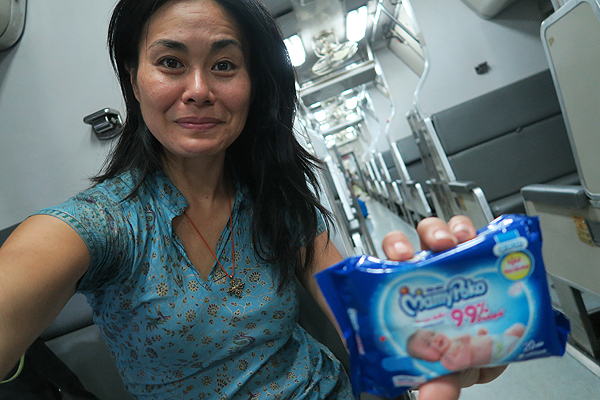
24. Hand sanitizer
I try not too be too germaphobic. But I still take hand sanitizer (or sanitizing wipes) because many toilets in India and Southeast Asia don’t have sinks to wash up in. I’ve also used them for occasions where I’ve accidentally peed on my shoe while using the squat toilets. Yes, I do have accidents from time to time.
Tip: You will experience the squat toilet in India. It is the most common type of toilet in India. Whereas Southeast Asia you’ll come across the handheld bum gun, squat toilet or western toilet.
25. Feminine Urinary Device (optional)
For those who haven’t had experience with the squat toilet or have bad knees, I recommend a female urinary device like the Freshette or the GoGirl. In India and Southeast Asia, you will have a run in with a squat toilet sooner or later. (For more on how to use it, read here).
26. Tissues or Toilet paper
It is handy to carry a packet of tissues or toilet paper with you. They are not always available at public toilets or when you are traveling by bus and unexpectedly stop at a rest stop bathroom or… field (I had this happen in Cambodia). You can easily buy packets of tissue at convenience and local shops for cheap, but note the tissues you buy will not be similar in strength to the west. Tissues in Asia are usually good for only one wipe or blow and tear easily afterwards; they are literally ” tissue paper”.
Packing List for Electronics
27. Unlocked iPhone with mobile hotspot .
People often want to know what type of factory unlocked phone to get. Whichever phone you buy, make sure it syncs with your information and is compatible with your computer.
Tip: Unlocked phones are best bought direct from the dealer or “factory unlocked”. While there are sellers out there who offer AT & T unlocked phones (etc), there’s always a gray line. With services which promise to hack into your phone and turn it into an unlocked phone, there’s always a concern about what will happen when you want to conduct upgrades of your mobile OS system. Yeah, those damn system upgrades.
28. Multi-plug Surge protector
A multi-plug surge protector should be part of your travel kit if you carry a bit more than a mobile phone and camera. As a travel blogger and vlogger, I’m a big techie, but it was essential to me long before that also. Great for hostels and hotels, it helps save money and time when you either, don’t want to carry many adapters or forget where you placed things for charging. Power spikes can happen however, it’s only really happened to me once during an electrical storm (where it fried my MAC laptop battery). The wattage goes up to 220v. If you’re in the U.S., then your electrical devices often take 110v, but many are equipped to handle up to 220v (thank God). Usually your allowance is show on your device’s power cord or on the back of its body somewhere. Still, if you feel your battery heating up or your laptop vibrate when you touch it, it’s due to this extra voltage it’ll be getting.
29. Universal travel adapter
For India (and if you plan to travel Southeast Asia), C,D & M adapter are the main squeeze! I already have those adapters from Korea which I use, but most travelers will find it easier and a more convenient investment to get a universal travel and USB adapter.
30. Solar Charging External Battery Chargers
Solar charging external batteries save you on long flights and long train and bus rides. The latter two are something you’ll definitely find in both, India and Southeast Asia.
31. Global wifi
You can get a Indian SIM card for internet; although it is a bit of an effort and occasionally your SIM can go bad. Thailand sells SIM cards at 7Eleven. OR you can just get a Skyroam global wifi hotspot (get 10% off using my referral code: GRRRLTRAVELER) and take your internet connection anywhere.
Packing List for Money & Currency
India and Southeast Asia are primarily cash based countries. Credit cards are only used for large purchase in stores and hotels. There are money changers & ATM machines at airports and banks .
32. Cash
Having a major form of currency, such as U.S dollars or British pounds is ideal to have entering any country. Sometimes, ATM cards don’t work or if you forgot to notify your bank of your travels, your bank card gets locked. Cash is a backup in the case you need to go to the airport money exchange (which I have had to do several times).
33. Indian Rupees (or currency of the country)
If anyone tells you taking rupees out of India is illegal they are only partially corect. You can take no more than 25,00 Rs out of India. I never leave with that much. Usually, I have about a 100 Rs and change left after a trip that I bring back with me as a safety precaution as my ATM cards occasionally meet problems in India.
Tip: Never accept torn rupees from vendors or anyone else.
34. Travelers Checks
UPDATE: Traveler’s checks are no longer accepted in India. Five years ago they were accepted forms of payment. I used them because I had to pay my yoga teacher’s certification program with cash (they didn’t accept credit card payments).
35. ATM card
ATM fees can be costly- best withdraw large chunks at a time. Check to see if your bank has foreign transaction fees to your withdrawals. Most do. A recommended travel card is Charles Schwab, which is said to waive foreign transaction fees. HSBC credit cards do this as well. Capital One Venture credit card is another favorite for me, especially where travel points are concerned.
36. Do Credit Cards work in India?
Credit cards might only work with big hotels and large purchases at stores. Otherwise, you won’t be using them, but they’re a safety backup for booking onward travel online. Visa credit cards are widely favored over Mastercard. American Express can only be used with high end hotels.
Solo Travel Packing Essentials for Luggage
37. Daypack
This is up to personal style but I always take a daypack for things like my camera, laptop and valuables. It is often glued to the front of my chest and I never let it alone.
38. Backpackers backpack
During my first two trips I took a North Face Terra 45L Backpack. It’s a classic fave and has a lot of pockets for storing things on the outside of your pack because face it, do you really want to dig in your pack while you’re traveling on a train? Ergonomics and support is perfect. 45L is medium sized; you don’t want to go much larger than that unless you’re a football player.
39. Convertible carry-on (the best luggage for solo travel)
As I get older, I like to think I get wiser. Gone are the days of being a sherpa to my travel gear. Instead, I like a bit of comfort, minimizing my sherpa abilities. This is the ideal size for minimalists even if you’re traveling for months. If you’re taking the train or bus, you’ll have an easier time with a smaller pack. Eagle Creek Doubleback22 3-in-1 Carry-on Luggage is my Swiss Army carry-on backpack convertible. It is lightweight, durable, weather resistant. Read my review to see all the features.
